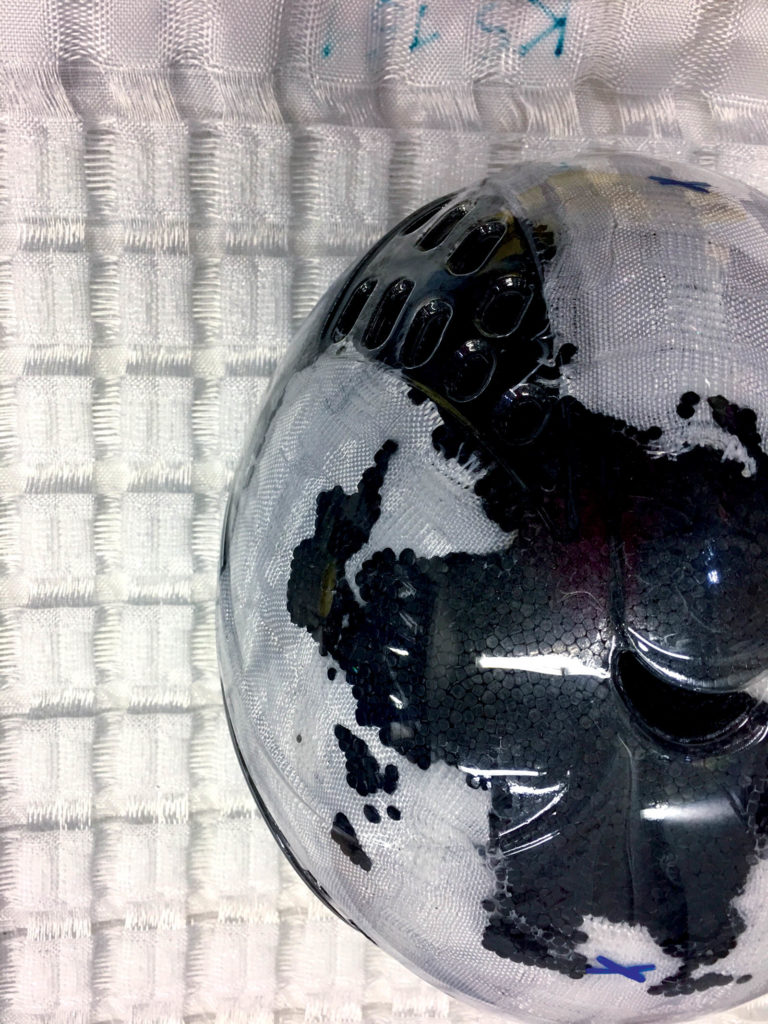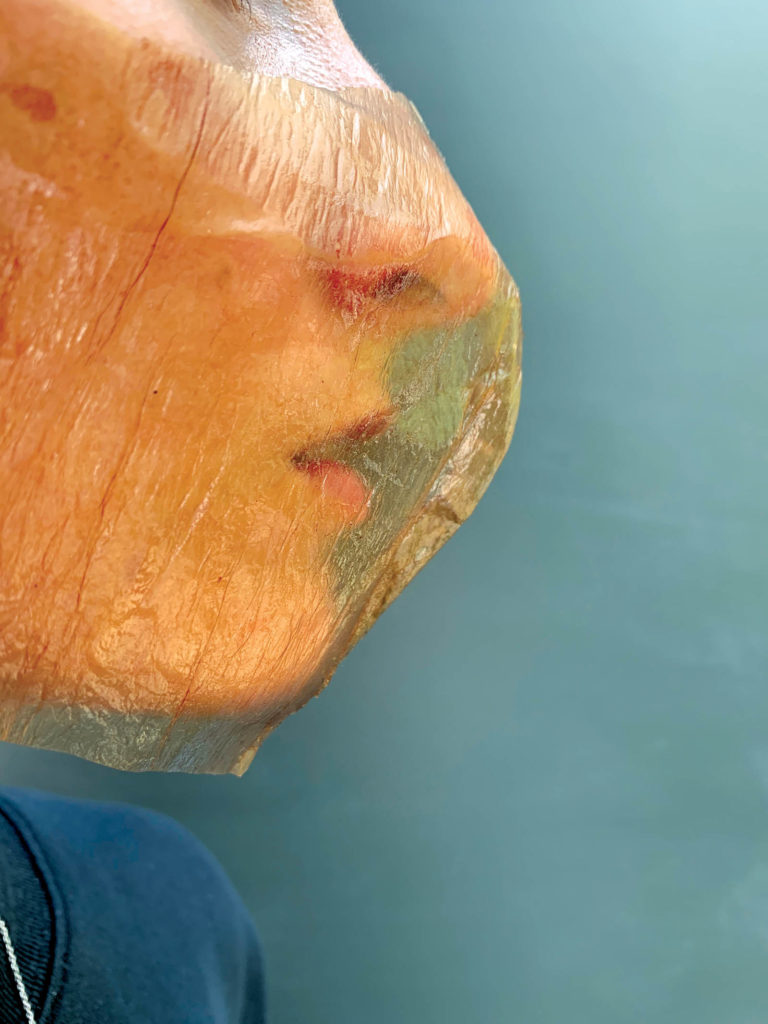by Marie O’Mahony

Health and safety are proving to be key drivers of innovative new fabric structures. These can prompt new designs in existing products and devices, or even whole new products. This is possible with imagination, expertise and an openness to look for solutions outside conventional thinking.
Strength can, of course, include hardness, but to be truly effective it may also need to be flexible rather than rigid, particularly when worn on the human body. An understanding of the importance of comfort to performance and user acceptance has prompted a welcome evaluation of materials, particularly where there is weight-saving to be made or a design innovation. Four developments from different global regions illustrate the potential for novel textiles to guide design and deliver medical and protective benefits to the user.
A layered approach
A 3D weave coupled with foam has been shown to provide an ideal structure for impact absorption and dissipation in protective helmets. Researchers at the German Institutes for Textile and Fiber Research Denkendorf (DITF) are utilizing a 3D weaving process to produce a spacer fabric that can be foam-filled and molded to form the basis for a three-dimensional, spherical structure such as a ski helmet.
Fiber use and placement can be optimized so that additional fibers can be used in the outermost layer where full coverage is required, but near the head a grid-like formation provides for a snug fit with minimal contact points. This approach maximizes the capacity for shock absorbency while at the same time reducing weight and material use. The combination of woven spacer and particle foam is shown in testing to increase the capacity for shock absorption by 30 percent over conventional designs.
Tattoo inspired
Patients undergoing surgical treatment for throat cancer can suffer from a temporary or even permanent loss of voice, as well as risk facial disfigurement. Researchers at Soochow University in China and the National University of Singapore are developing a very thin tattoo-like epidermal patch as a human-machine interface (HMI) to improve a patient’s ability to communicate. The patch is able to record surface electromyography (sEMG) created by the patient’s facial muscles and jaw movement that allows for smart voice recognition, voice synthesis and virtual interaction.
Until now, measurements have relied on the use of rigid electrodes attached to the skin using gel and adhesive tape or straps that are not well suited to daily use. The new device can be more discreetly attached to the face or jaw, and uses advances in soft, flexible electronics with a sterile wound dressing sandwiched between the face and patch, providing protection and adhesion.
Tremor control
Researchers in Switzerland led by Empa, Swiss Federal Laboratories for Materials Science and Technology, are developing an adjustable, inflatable textile orthotic for wrist tremor suppression in patients. Essential tremor (ET) affects an estimated 2.2 percent of the U.S. population over the age of 65, with Parkinson’s disease patients being the second highest group suffering from movement disorders. Neither are curable, but tremor suppression orthoses are an option.
The researchers used a textile “glove” designed to be easy to put on and take off, lightweight, flexible and not irritating to the skin. Air inflating the membrane structure allows for variable stiffness that can be regulated by the user. This can be adjusted for specific tasks either with a hand pump or a small switch-activated electrical pump.
An innovative new laser-welding technique uses an infrared laser to create a mechanically strong but flexible seam. The flexibility it allows for—in a range of 3D shape designs—is greater than what is possible with more conventional methods, such as hot press. The resulting orthosis offers a lightweight design weighing only a little more than an ounce, helping to prevent muscle fatigue.
This is particularly important when used over long periods of time or for elderly patients where there is a high risk of reduced skeletal muscle mass. Tests that have been undertaken with three of six key tasks (drinking from a cup, pouring water and drawing a spiral) are showing positive results.
While it may be simplistic to say that in looking at the potential for advanced and smart textiles in health and safety we should just look at replacing heavier or less flexible materials with textiles, there is still much to be gained by looking afresh within the textile sector itself or, for that matter, beyond our usual understanding of textiles at all.
Home-grown cellulose mask
A pair of bio-designers, Elizabeth Bridges and Garrett Benisch of Sum Studio in New York City, have created an antimicrobial cellulose face mask. The bio-designers suggest this material could offer a credible longer-term supply solution for personal protective equipment (PPE).
During the current COVID-19 pandemic, the race has been on to provide adequate PPE. Designers, manufacturers and individuals at home are offering creative solutions ranging from 3D printed shields to DIY face masks.
N95 masks are made from meltblown nonwoven material designed to filter particles containing pathogens. These materials are paramount in the fight to stop the spread of COVID-19, yet essential workers have not had an adequate supply in many areas of the country. One reason for that is the machining and precision required to make the fabric; the machines that create meltblown fabrics are expensive, complex and take months to build.
Bridges and Benisch have looked to the natural world, which is full of filters, membranes and woven barriers that are ready to be utilized or mimicked. To prove just how accessible these materials are, they decided to grow their own bacterial cellulose face mask in their home kitchen, while working on ways that this prototype could be iterated to function like meltblown N95 fabric.
Bacterial cellulose is created by common bacteria called Acetobacter xylinum on the surface of a liquid they inhabit. The bacteria and their cellulose craftwork can be grown with as little as water, tea, sugar and a small sample to feed and let flourish. As the bacteria multiply, they knit cellulose fibers into a single membrane that can be harvested and dried as a workable material. Though it is translucent and smooth to the human eye, microscopic images show the tight web of cellulose fibers that make up this natural knit.
Once the material is thick enough, it can be removed and hung to dry as a flat sheet that’s flexible and strong, but easily degrades into the environment. It can be waterproofed and oiled with natural ingredients to have the softness and strength of thin leather. The entire process takes approximately two weeks. With multiple batches staggered in time, the designers suggest that the production of this material could be scaled up quickly.
In these few examples we see how weaving can be sandwiched with foam in new ways, how flexible electronics and wound dressings can benefit one another without full integration, how a new laser welding technique can open up opportunities for textile structures, and how an idea literally cooked up in a home kitchen can all supply creative pathways forward. They also teach us how solutions are frequently found in the details and in the vision of the creators.
Marie O’Mahony is an industry consultant, author and academic based in Toronto, Ont., Canada. She is the author of several books on advanced and smart textiles published by Thames and Hudson and is a visiting professor at the Royal College of Art (RCA), London.
SIDEBAR: Home-grown protection
In just two weeks and using a home kitchen, two bio-designers had enough material to make a protective mask created by Acetobacter xylinum bacteria effective in blocking exposure to the coronavirus, and one that would biodegrade when it was no longer used. Photo: Elizabeth Bridges and Garrett Benisch, Sum Studio.
 TEXTILES.ORG
TEXTILES.ORG



